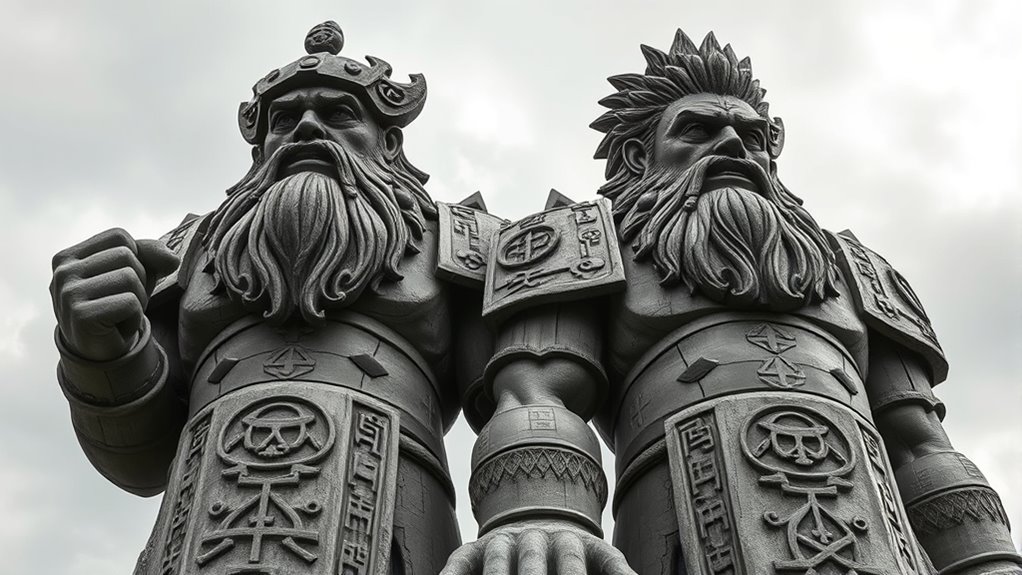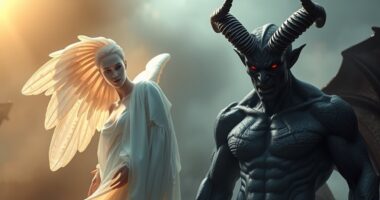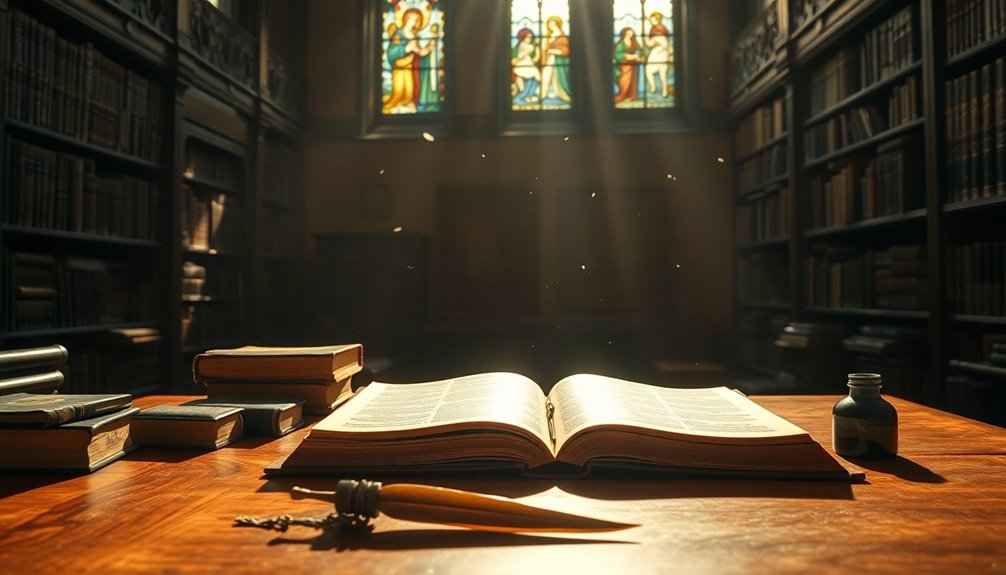Gog and Magog are ancient figures rooted in religious texts symbolizing apocalyptic nations or forces of chaos. They appear in biblical writings like Ezekiel and Revelation, representing battles between good and evil, chaos and order. Over time, interpretations vary across cultures, sometimes seen as monsters, tribes, or symbols of destruction. Their stories influence legends and modern ideas about global conflict or divine judgment. If you want to uncover their deeper significance, keep exploring their intriguing history.
Key Takeaways
- Gog and Magog are biblical figures mentioned in Ezekiel 38-39 and Revelation, often representing nations or forces of chaos.
- They symbolize enemies in apocalyptic prophecies, associated with a final battle against divine forces.
- Historically, they are linked to nations or tribes destined for conflict, embodying chaos and divine judgment.
- In various cultures, Gog and Magog are mythologized as giants, monsters, or protectors involved in end-times legends.
- Modern interpretations see them as symbols of global conflict, chaos, or moral tests reflective of geopolitical and spiritual tensions.
Origins in Religious Texts

Gog and Magog first appear in ancient religious texts as mysterious figures representing chaos and future conflict. These mythological creatures are often linked to apocalyptic prophecies, where they symbolize the chaos unleashed at the end of times. Their origins trace back to biblical writings, particularly in Ezekiel and Revelation, describing them as nations or tribes destined to clash in a final battle. Over centuries, their stories have been woven into various religious traditions, fueling fears of impending destruction. As legendary figures, Gog and Magog embody the themes of chaos and divine judgment. Their mention in ancient scriptures cements their status as symbols of cataclysmic events, making them enduring figures in apocalyptic lore. Their mysterious nature continues to fascinate and inspire interpretations across cultures.
Symbolism and Interpretations

The stories of Gog and Magog have evolved far beyond their origins in ancient texts, taking on layers of symbolic meaning across different cultures and eras. They often represent prophetic symbolism, embodying fears of chaos, destruction, and divine judgment. In many interpretations, Gog and Magog symbolize forces of evil or chaos that threaten the world’s stability, especially in apocalyptic imagery. These figures serve as powerful symbols of impending catastrophe, warning of a final confrontation between good and evil. Their imagery is used to evoke a sense of urgency and moral testing, highlighting themes of divine justice and redemption. Overall, Gog and Magog stand as enduring symbols, shaping how cultures envision ultimate battles between order and chaos in apocalyptic visions.
Historical Accounts and Legends
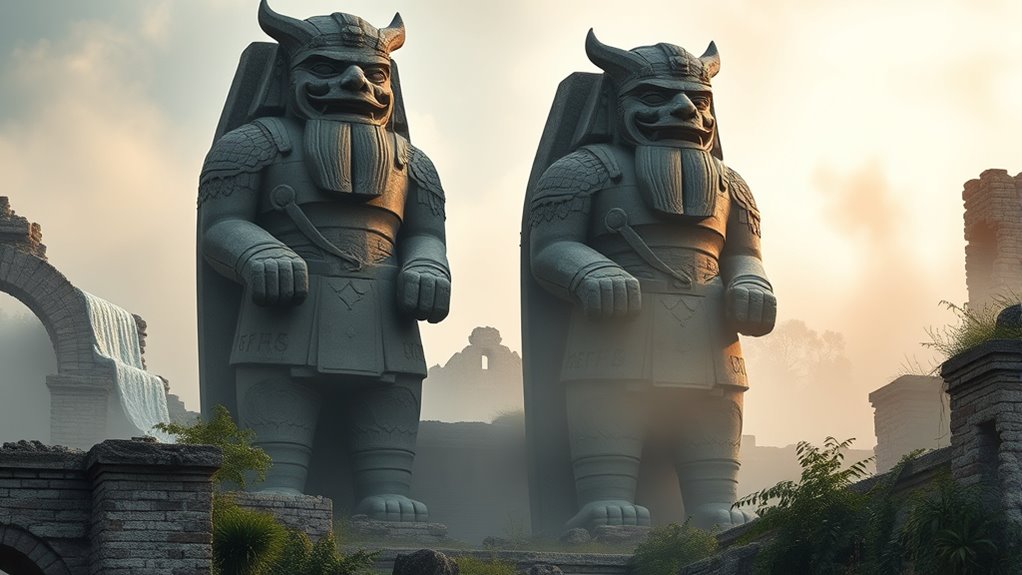
Throughout history, legends of Gog and Magog have captivated cultures around the world, often blending myth with historical memory. Ancient prophecies mention these figures as powerful, sometimes apocalyptic, forces. Over centuries, stories evolved, portraying them as mythical creatures or giants who would play roles in end-times battles or divine plans. In medieval legends, Gog and Magog appear as guardians or adversaries, symbolizing chaos or enemy nations. These accounts often merge myth with real historical events, giving them a sense of authenticity. While some believe they represent actual tribes or peoples, others see them as allegorical symbols of chaos and destruction. Regardless, their recurring presence in legends highlights their significance as archetypes of upheaval and prophecy across different eras.
Cultural and Geographical Variations
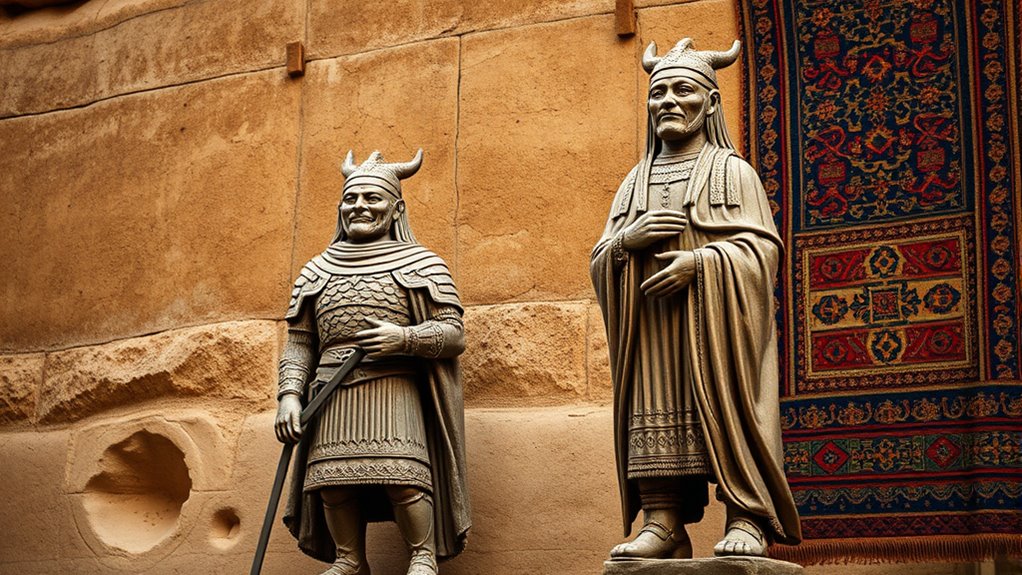
Across different cultures and regions, stories of Gog and Magog take on distinct meanings and significance. In some traditions, they are seen as mythical monsters representing chaos or destruction, embodying powerful eschatological symbols. Their roles vary from protectors to adversaries, depending on cultural context. You’ll find that in Western legends, Gog and Magog often symbolize the chaos preceding a new era, while in Middle Eastern stories, they’re linked to apocalyptic battles. Their portrayal influences local arts, folklore, and religious narratives. These variations highlight how different societies interpret these figures as symbols of ultimate conflict or renewal. Understanding these cultural differences helps you see how mythic monsters like Gog and Magog serve as universal symbols with diverse, region-specific meanings.
Modern Perspectives and Theories
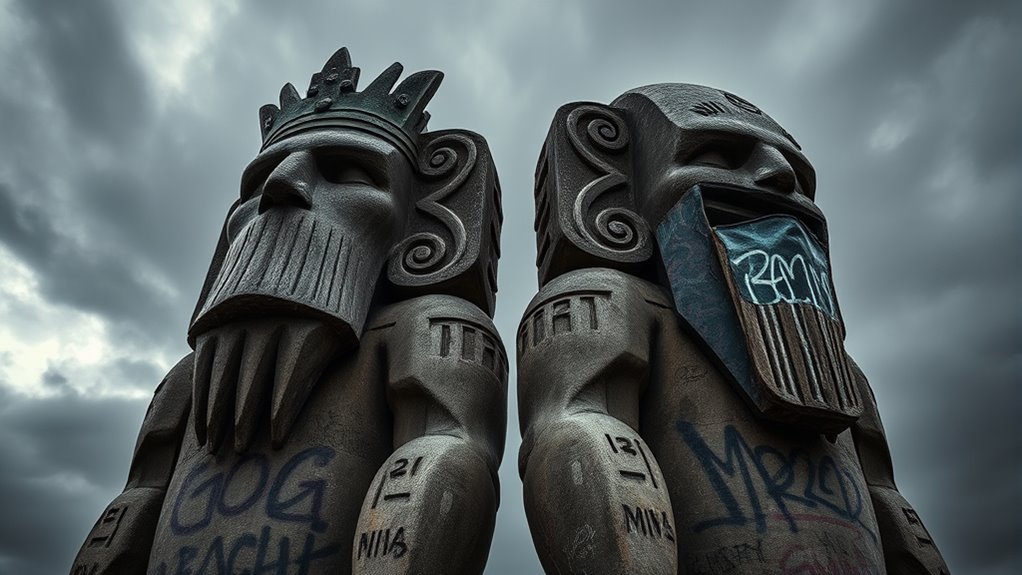
Modern perspectives see Gog and Magog as powerful symbols representing chaos or conflict in today’s world. Some theorists connect these figures to current geopolitical tensions, imagining them as prophetic allegories. Exploring these interpretations can deepen your understanding of how ancient myths influence modern political thought.
Symbolic Interpretations Today
Today, scholars and enthusiasts interpret Gog and Magog as powerful symbols reflecting contemporary fears and cultural conflicts. They often see these figures through the lens of apocalyptic myths and prophetic symbolism, representing chaos, destruction, or societal upheaval. Some view Gog and Magog as allegories for global threats like war, climate change, or ideological extremism. Others believe they symbolize the clash of civilizations or the struggle between good and evil in modern times. These interpretations help us understand how ancient narratives continue to shape current fears and hopes. By framing Gog and Magog as metaphors, you can explore their relevance beyond literal predictions, emphasizing their role in expressing collective anxieties and moral questions of today.
Geopolitical Speculations
Have you ever considered how interpretations of Gog and Magog influence current geopolitical theories? Many analysts see these figures through the lens of ancient myths and apocalyptic prophecies, imagining them as symbols of chaos or conflict that could ignite global crises. Some theorists link Gog and Magog to modern nations or groups, suggesting their emergence signals impending upheaval. These ideas often stem from a desire to interpret ancient texts as warnings or forecasts for today’s world. While critics argue these connections are speculative, they nonetheless shape geopolitical discourse, fueling fears of conflict and global instability. By framing current events within these mythic narratives, you might find yourself viewing international tensions through a lens colored by ancient myths and apocalyptic prophecies, influencing perceptions of threat and future conflict.
Significance in Contemporary Thought

Gog and Magog continue to symbolize the enduring struggle between chaos and order in contemporary thought. They often appear in apocalyptic prophecies, representing forces that threaten stability and peace. Modern interpretations see these mythological creatures as metaphors for chaos’s unpredictable nature, challenging societal norms. You might encounter their names in discussions about global conflicts, environmental crises, or religious narratives warning of impending doom. Their presence fuels debates about morality, destiny, and the limits of human control. Recognizing their symbolism helps you understand how ancient mythologies influence current worldviews. These figures serve as a reminder that chaos remains a persistent challenge, urging societies to seek order amidst turmoil. Ultimately, Gog and Magog embody the timeless struggle between destruction and renewal.
Frequently Asked Questions
Are Gog and Magog Mentioned in Non-Abrahamic Religions?
You might wonder if Gog and Magog appear in non-Abrahamic religions. While mainly rooted in Abrahamic traditions, these mythical warriors also serve as powerful cultural symbols in various societies. In some cases, they represent chaos or upheaval, crossing religious boundaries. Their stories often symbolize universal themes of conflict and protection, showing how different cultures interpret these figures as symbols of larger forces rather than specific religious entities.
How Do Different Cultures Depict Gog and Magog Historically?
Think of Gog and Magog as mythical symbols wandering through history’s tapestry. Different cultures paint them with unique brushstrokes, reflecting their fears and hopes. In some traditions, they’re monstrous invaders, while others see them as apocalyptic heralds. These cultural variations reveal how societies use myth to interpret chaos and order, transforming ancient fears into legendary figures that embody universal themes of conflict and renewal across diverse civilizations.
What Are the Modern Geopolitical Implications of Gog and Magog?
You might see Gog and Magog as symbols in modern geopolitics, representing global conflicts or threats. Their image fuels geopolitical symbolism, often used to warn of chaos or invasion. In contemporary conflict interpretations, they symbolize fears of chaos, war, or the clash of civilizations. Recognizing these symbolic meanings helps you understand how ancient myths influence current political narratives and how fears of upheaval shape international relations today.
Are Gog and Magog Linked to Any Specific Historical Figures?
You might wonder if Gog and Magog are linked to specific historical figures, but their mythical origins are rooted in prophetic symbolism rather than actual persons. Historically, they represent forces of chaos and conflict in biblical and apocalyptic texts. These figures symbolize broader themes like divine judgment and future battles, rather than individual identities. Their significance lies more in their symbolic meaning than in any direct connection to real historical individuals.
How Do Contemporary Scholars Interpret Gog and Magog’s Symbolism Today?
Imagine a mirror reflecting humanity’s fears and hopes—today, scholars see Gog and Magog as powerful symbols of chaos and conflict. In contemporary debates, these figures embody the struggle between good and evil, chaos and order. Symbolic interpretations vary widely, sparking scholarly debates about their relevance in modern times. You can interpret them as warnings or allegories, revealing how history’s monsters continue to shape our collective consciousness.
Conclusion
As you explore the stories of Gog and Magog, you see them as ancient shadows cast across time, their legends like echoes of a distant storm. Whether symbols of chaos or prophecy, they remind you that myths are the tapestry of human imagination, weaving fears and hopes into a vivid mosaic. In understanding them, you glimpse the timeless dance between fear and faith, a story as old as the stars themselves.

